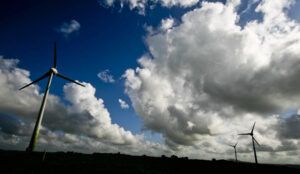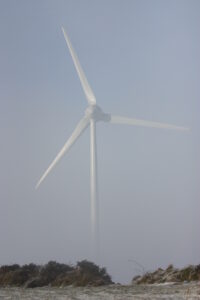Archiwum dla miesiąca: July 2025
Electricity Prices Drop Again as Wind and Solar Power Hit Record Levels
Ireland sees lowest wholesale electricity prices since April, driven by strong renewable energy output
Electricity prices in Ireland continued to fall in June, with the average wholesale cost per megawatt hour dropping to €95.21—its lowest level since April 2024. This marks the fifth consecutive month of decline, according to a new industry report.
On days with high wind energy output, prices fell even further to €67.15 per megawatt hour, compared to €115.06 on days when fossil fuels supplied nearly all demand.
Wind farms provided 30% of Ireland’s electricity in June, while solar farms recorded their best month ever, boosting the overall share of renewable energy.
Electricity demand rose slightly compared to previous months, the report noted.
“Our members provided nearly a third of Ireland’s electricity during the first half of 2025,” said Noel Cunniffe, CEO of Wind Energy Ireland. “Last month was particularly strong for renewable generation.”
Cunniffe emphasized the economic and environmental benefits of renewables.
“Wind farms are Ireland’s leading source of clean electricity. They cut our reliance on imported fossil fuels and improve energy security,” he said. “Every turbine or solar panel pushing electricity into the grid helps lower prices.”
Since 2000, renewable energy is estimated to have saved Irish consumers nearly €1 billion in electricity costs. In 2024 alone, wind farms in counties like Kerry, Cork, and Mayo helped reduce Ireland’s gas spending by over €1.2 billion.
Wind Power Met 30% of Ireland’s Electricity Demand in June
Ireland’s wind farms kept the energy flowing in June, supplying 30% of the country’s electricity needs — a small but meaningful increase from the same time last year.
According to Wind Energy Ireland’s latest report, overall electricity demand in June rose slightly to 3,151 gigawatt-hours (GWh), up from 3,019 GWh compared to June 2024. At the same time, wind energy generation jumped to 939 GWh — a solid rise from 771 GWh a year ago.
“This was a strong month for renewable energy in Ireland,” said Noel Cunniffe, CEO of Wind Energy Ireland. “Nearly one-third of the country’s electricity during the first half of 2025 came from wind power. If we can keep building more wind and solar farms, we’ll cut our need for imported fossil fuels and help lower costs for everyone.”
And speaking of costs — there’s more good news. The average wholesale electricity price dropped for the fifth month in a row, down to €95.21 per megawatt hour. That’s the first time prices have dipped below €100 this year and the lowest we’ve seen since April 2024.
Not surprisingly, windy days helped bring those prices down even further. On days with the most wind power, electricity cost just €67.15 per megawatt hour. But on days when fossil fuels were doing the heavy lifting, the cost shot up to €115.06.
“Affordability really matters to Irish families and businesses,” Cunniffe said. “Every time a wind turbine spins or a solar panel soaks up the sun, it helps reduce prices and boosts our supply of clean, homegrown energy.”
The report also highlights how different counties contributed to Ireland’s wind power. Kerry led the way last month, generating 105 GWh — about 11% of the total wind energy produced. Cork followed with 83 GWh, then Mayo (65 GWh), Galway (64 GWh), and Offaly (61 GWh).
Cunniffe pointed out that wind farms like those in Kerry, Cork, and Mayo helped Ireland save over €1.2 billion on gas last year. “Instead of sending that money abroad to buy gas, we kept it here — supporting Irish jobs, communities, and businesses.”
Looking ahead, he said the focus now is on speeding up the rollout of new wind farms: “To meet the needs of our growing economy, we need to move faster. We’re ready to work with the Government to make that happen.”
Discussion of Mayo windfarm on Oliver Callan RTE
click here for the discussion on Oliver Callan’s RTE radio show re Belmullet National Park bog and major windfarm in the area (6mins in)
Offshore Wind Farms on the Irish Sea
Plans for massive floating wind farms off the Welsh coast—set to be among the largest in the world—are expected to power around four million homes and create over 5,000 jobs, according to a government minister.
The project, a partnership between the Crown Estate, Equinor, and Gwynt Glas, aims for completion by the mid-2030s. Turbines up to 300 meters tall will be assembled in Bristol and Port Talbot before being floated to their offshore locations.
Jo Stevens, Secretary of State for Wales, praised the initiative during a visit to Port Talbot, calling it “great news” for Wales. She highlighted the job creation and inclusion of apprenticeships as a boost for young people.
The Crown Estate is investing £400 million into the UK’s offshore wind supply chain. Although profits go to the Treasury, the Crown Estate—owned by the monarch—manages the seabed around Wales and remains under UK control, despite calls for devolution similar to Scotland’s.
Stevens defended Westminster’s oversight, arguing that keeping control ensures investor confidence and project certainty. However, Plaid Cymru’s Llinos Medi criticized the lack of devolution, saying profits would leave Wales instead of benefiting local communities.
Energy Secretary Ed Miliband described floating wind as transformative for Wales and southwest England. Welsh First Minister Eluned Morgan welcomed the announcement as a key moment in launching a new global energy industry and urged companies to base operations in Wales.


